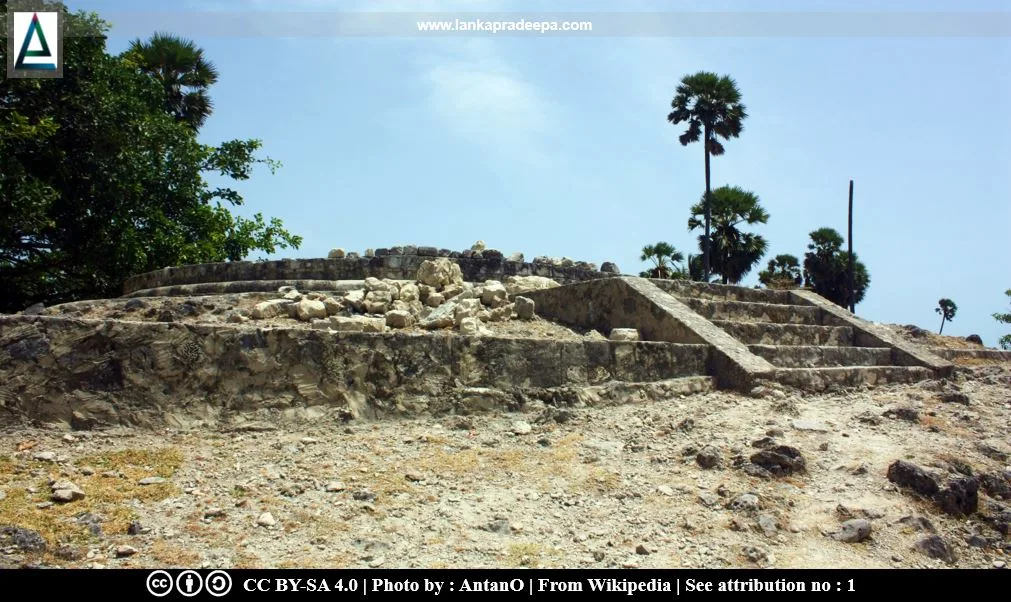
A site with the remains of an ancient Buddhist temple has been discovered in the north-western part of Delft Island, Jaffna District, Sri Lanka (Devendra, 1969; Dias et al., 2016; Goonatilake et al., 2013; Ragupathy, 1987; Wijebandara, 2014). The area where these ruins are scattered is presently known as Vetiyaracan Kottai (the Fort of Vedi Arasan) by the locals (Goonatilake et al., 2013; Wijebandara, 2014).
History
This site is identified as the only place on the island that had been subjected to the earliest human activity (Dias et al., 2016). It is estimated that their origin dates back to the 2nd century B.C. (Dias et al., 2016; Wijebandara, 2014). However, definitive evidence about the construction of the Stupas on the island is obscure to date (Dias et al., 2016; Wijebandara, 2014). Sri Lankan chronicles reveal that there were several Buddhist temples in the Jaffna Peninsula during the Anuradhapura Period (Goonatilake et al., 2013). According to the view of Ragupathy, this site is possibly a place of Buddhist warship patronized by the ancient traders (Ragupathy, 1987). It could have been abandoned after Hindu influence that took place intensively during the time of the Jaffna principality (Ragupathy, 1987).
Local legends
Local people identify this site as Vetiyaracan Kottai (the Fort of Vedi Arasan) because they believe that these ruins belong to Vetiyaracana (or Vedi Arasan), a legendary Tamil figure (said to be the king of Mukkuvar caste) found in local tradition (Devendra, 1969; Ragupathy, 1987).
Stupas and other ruins
There are remains of Buddhist Stupas and other ancient structures including fragmented Buddha statues, Yantra-gal, socket stones, etc. (Goonatilake et al., 2013; Ragupathy, 1987). These remains are scattered in an area of about 15-20 acres (Goonatilake et al., 2013; Ragupathy, 1987). Apparently, these structures had been built using chiselled and unchiselled corals (Goonatilake et al., 2013; Ragupathy, 1987).
Stupas
Circular basements of three Stupas have been identified at the site (Devendra, 1969; Goonatilake et al., 2013; Ragupathy, 1987). In 1969, Devendra recorded a fragment of a Dagaba-spire (Kot-Kerelle - the upper portion of a Stupa) that he observed during a visit to the site (Devendra, 1969). The Stupa basements were partially restored by the Department of Archaeology in the late 1970s (Goonatilake et al., 2013; Ragupathy, 1987).
The main Stupa has been built at the highest elevation in the area and its remaining base is 34 feet in diameter (Dias et al., 2016). Recent restorations have made it a 3 feet high monument (Dias et al., 2016; Wijebandara, 2014). The bases of two other small Stupas are found on the west and the east of the main Stupa (Dias et al., 2016; Wijebandara, 2014). The Stupa base on the eastern side has a diameter of 10 feet (Wijebandara, 2014). Ruins of some ancient structures are also found in the north-eastern part of the main Stupa (Wijebandara, 2014).
Other artefacts
Analysis of pottery remains (such as black and redware, roulette ware) that were discovered at the site have revealed evidence of the first few centuries of the Christian era (Goonatilake et al., 2013; Ragupathy, 1987). In 1987, Ragupathy recorded fragments of copper, iron tools (nails), iron slags, pestle
stones, grooved tiles, carnelian beads, glass beads and a copper coin
that belonged to King Sahassamalla (c.1200-1202 A.D.), from this site (Ragupathy, 1987).
Destruction
Most of the ruins of ancient structures have been moved by locals to construct fences, wells, and other structures (Goonatilake et al., 2013).
A protected site
The ancient Vediarasan Fort situated close to Mangaraikarasi Vidyalaya belonging to Delft Grama Niladhari Division bearing No. J-1 in the Divisional Secretariat Divison of Delft West is an archaeological protected monument, declared by a government gazette notification published on 23 February 2007.

.
See also
#) Delft Island Archaeological Heritage
Attribution
2) Old Stupa (Delft Island) by Amila Tennakoon is licensed under CC BY 2.0
References
1) Devendra, D.T., 1969. A ruined Dagaba in Delft. The Journal of the Ceylon Branch of the Royal Asiatic Society of Great Britain & Ireland, 13, pp. i-iii.
2) Dias, M.;
Koralage, S.B.; Asanga, K., 2016. The archaeological heritage of Jaffna peninsula. Department of Archaeology. Colombo. pp.217-218.
3) Goonatilake, S. de A., Ekanayake, S., Kumara, T.P., Liyanapathirana, D., Weerakoon, D.K., and Wadugodapitiya, A. 2013. Sustainable Development of Delft Island: An ecological, socio-economic and archaeological assessment. International Union for Conservation of Nature, Colombo, Sri Lanka & Government of Sri Lanka. pp.29-30.
4) Ragupathy, P. 1987. Early settlements in Jaffna, An archaeological survey. Published by Mrs. Thilimalar Ragupathy. Madras. pp.17-22.
5) The Gazette of the Democratic Socialist Republic of Sri Lanka. no: 1486. 23 February 2007. p.129
6) Wijebandara, I.D.M., 2014. Yapanaye Aithihasika Urumaya (In Sinhala). Published by the editor. ISBN-978-955-9159-95-7. pp.62-63.
Location Map
This page was last updated on 3 January 2023


